A 365-Day Project
"We Are All Mozart"
A project to create
new works and change
the perception of the
music of our time.

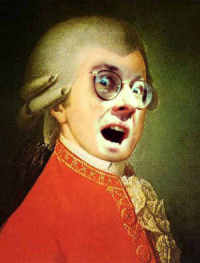
 June 21, 2006
June 21, 2006 
Composing is an exhausting business, but aside from the music, there are some exhilarating aspects of the life. One of them is notation. No, really. I know what you're thinking -- lines & black dots on a page, so what? But this is a brilliant system of communication, a true phenomenon of cooperation and heritage across time.
It's a very old system -- some call it a language, but it's really just a set of instructions. Yes, it can be an artform in itself in the way typography and book design produce the volumes that are treasured and handed down, and original manuscripts bear the stamp of a creator's character. But unlike words, music notation doesn't contain the same level of implication and meaning.
That's not really what I've been thinking about, though. I've been considering the notation itself, and how we include or hide as much as we wish to lead the way into performance.
The process has become more specific as a defensive measure against a spreading culture and specialization of the composers' and performers' trades. In a tight-knit community, one might only need say, "Turn left at the general store, head up through the covered bridges and stop at the green house with the blue door." But for the correspondent from Moscow, a letter is sent to a person in Northfield, Vermont, US, zip code 05663, street name and number required, and it's all to be done in Roman letters. Different instructions are required for the same geographical location, the same house, the same people, the same blue door. The specificness is infectious. Letters from across the bridge demand the entire address because they travel 100 miles away and back.
So composers have an ever-enlarging toolkit for tailoring their instructions for accuracy and communication across years & cultures while creating a fluid, real-time reading ability that simultaneously protects against turning the musical notation an impenetrable maze of symbols and languages.
And I do love this toolkit. It includes delicious ways of describing pitches and rhythms and harmonies and colors and actions and expressiveness. Two of these and one of those. Put 'em here and then stop. Yeah, make it hot. Remember to chew well. Don't forget the blue door. Delivery night or day.
Notation isn't a quiet little world of nodding bobbleheads, nuh-unh. Every addition or clarification a composer develops is met with a riot of resistance. Do we really need to do this? Isn't this too much? Why invent a new symbol when existing ones are close enough? Are you sure you mean that?
I prefer questions such as: How much does notation tell? How does it tell? What is left open? What is the balance of fixation and interpretation?
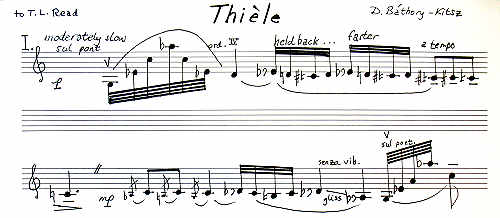
Thièle for solo violin notates quarter-tones, rhythms, strings, expressions, and techniques.
To composers, it seems clear: Tell what needs to be told. Be accurate enough to ensure your acoustic vision will be recreated.
What Happened?
It wasn't always that way because there was a time when everyone knew the green house with the blue door. Symbols could stand as reminders of what was largely an oral tradition. Later symbols stood in for customs. With publishing, even more clarity was needed. Between Venice and Vienna lay a small universe of differing expectations, styles, mores, and languages.
In the last century, notation underwent wrenching changes that culminated in John Cage's collection of many composers' works, called Notations. This book was my own epiphany as a pen-and-ink composer. I had been inventing notes-to-self on how to achieve effects or remind myself about the desired sounds, but until Notations, those were more crib sheets waiting to be translated than they were manuscripts to share. The book made it clear that musical notation was not a language but an instruction set, instructions provided in the manner most effective for achieving a finished result.
But what's obvious to a composer is not obvious to those with immense investments in the traditional system, where there are still great rewards to be had for recognizing the key of F minor and making the fingers or the lips or the voice correspond to the complete set of parameters that mean 'F minor'. The convenience of barlines and the accessibly repetitive rhythmic assurance they offer is not easily thrown over. Indeed, moving outside the bounds of 19th century notation in either direction would bring me a chorus of complaints over the years, complaints that meant "not enough information" or "too much information" or -- in latter days -- "too expensive to take the time."
It is surprising how much of the investment in 19th century notation is argued from an economic standpoint. Economics frees the argument from dealing with a performer's unlearned skills, including improvisation (whether or not avant-garde in nature), analysis, and an expanded vocabulary of symbols and techniques. There is always an unspoken subtext of "if it was enough for Beethoven...," albeit with a tip of the hat to exceptional exceptions such as Bartók's string writing.
I have no patience with this resistance. The conservatory is not the end of musical training, nor even the manuscripts of Stravinsky and Bartók. As each age brings its own concepts, it also carries with it the information required to carry out the performances. To fit new practices into older notation is ultimately fruitless, because the notation is neither sufficient nor capable of expressive implication. If I mean to show a geometric relationship of rhythms, then using a notehead/rhythm system with flexible placement is unsatisfactory. As readers of traditional symbols, we forget that the notation is symbolic, not accurate. We have learned that, although an eighth note and a whole note bear a specific mathematical relationship in time, their visual placement is malleable rather than precise, and intended for a traditional legibility that leads to reproduction. Likewise, though their frequency distance is equivalent (at least in tempered tuning), the visual distance F to F# does not match that of F# to G. We know what the differences mean within a tonal context, and forget that the written presentation is visually illogical.
Graphical notation's attempts at accuracy were disdained, but some three decades later, computer 'scoring' of sequenced works began weakening this stance. So-called piano roll notation, first adopted for practical visualization of events in time and frequency, has shown to be effective in itself as a notation system. (I once had a composition student in his eighties whose first and only notation was sequencer notation. By his practices, he taught me the irrationality of dot-music notation.)
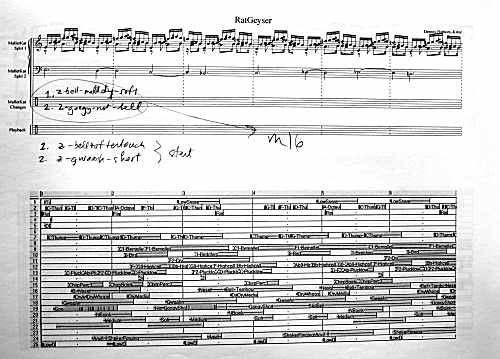
The first page of RatGeyser, for MalletKat and playback, contains standard notation and piano roll.
Another irony of the resistance to notational change is a bias against verbal instructions. It's ironic because, although pitch and rhythms are specified, a longstanding body of multi-language instructions has developed for tempo change, articulation, technique, and particularly expression. The blue-door assumptions shifted away, but not entirely. Once-familiar melodic phrases began to need dynamic marks (first two, now twelve), then slurs, and then hairpins were stuck in. But at some point -- and it's very hard to know where the balance tips -- the performer may dig in and reject the music's notation, and thus the music itself.
When a system has been codified, as notation was done by publishers in the 19th century, there is an expectation from symbols and an expectation of symbols. Yet what happens when the code begins to fail, when imagination goes beyond a system from the past?
What Should I Do?
If a pitch is notated, how does the performer know the composer's wish only to approximate a pitch? Conversely, if a complex rhythm is not notated, how can a performer reliably achieve that rhythm? How can a performance be coordinated with an electronic component? How are the electronic portions identified? Why does the indicating French Baroque style present no challenge, but indicating hard swing present an obstacle? What traditions of improvisation and style can be understood, and what must be specified? Composers working today must make choices that their 18th century counterparts did not face. (Some, yes. What's all this new Turkish percussion?) But multiphonics and microtones and the physical act of playing and spatialization and performer motion & placement and precision of action? And...?
Exercises can help. Two contrasting exercises might be to play a late Beethoven string quartet from re-notation as an architectural score -- a sequence of lines of different thicknesses and densities in time. Another might be to carefully re-notate the expressive lines in a Chopin prelude as specific rhythms and without barlines. Yet a third might be to re-notate a (pseudo-)Bach orchestral suite as harmonies for everyone (much like the figured bass) and provide entry points for quasi-improvised tunes and counterpoints.
The struggle to create music from these exercises is the same struggle a performer will face with a contemporary nonpop score: that is, contexts are grasped only through experience. The conservatory offers the body of historical contexts and experience in an easy-open package. Not so the continuing composer.
An example of this problem from my own repertoire was how to create the reproducible information needed for the sound environment of In Bocca al Lupo, which was essentially an extended composition with interactive content -- an opera for the space, in effect. The complete 'score' consisted of snippets of song and chant, processed natural sounds, and programs to produce electronic sounds in response to stimuli. The 'conductors' and 'arrangers' were me (in past time) and the gallery visitors (in real time), and the programs grew to learn their real-time conductors and change the character and dynamics of their 'performance' over the course of a month.
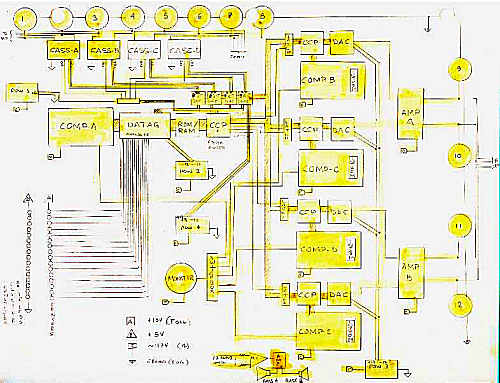
The block diagram to the In Bocca al Lupo installation, done in Montana in the mid-1980s.
As musicians all, we have grown up from (and through) the European axis of composed sounds. The comparatively sudden rise of a multi-level, multi-cultural, multi-expectation age has placed enormous stress on the notational practices which have refined themselves over a millennium within a constrained geography. Today, at the extremes of choice, some composers have returned to an oral and improvisational tradition while others have refined and extrapolated the notation further and incorporated indicative techniques from the other arts and sciences.
In other words, the problem has gotten deeper.
Why Should I Do It?
Now yer askin'! Sure, you might also ask, why do music? My answer: There's something to say, and a medium to be chosen in which to say it. My medium is sound.
The question was framed recently during a post-concert discussion. What is it about this new complexity? The composers don't really want that, do they? They really must mean to approximate what's there? Do they really know what they are doing? Or are they just being angry people?
Such questions infect the new nonpop business, and the attention to spiritualists like Pärt and post-neo-romantics à la Golijov or Adès or Liebermann make offering answers even harder than it was in the 1950s. (The resetting of the new nonpop center is part of the conservative times, an expression of what was learned in the last century -- and a vengeance. The ill will over 75 years of experimental demands on performers and critics was deep. There is an undertone of particular satisfaction that wholly misunderstands that this tonality is nothing like -- could be nothing like -- the tonality they misguidedly believe they remember so fondly.)
I'm avoiding the answer, or at least giving it some context. The answer is as simple fifty years after Gesang der Jünglinge as it was then: because that is how to reproduce the composer's vision.
Yes, it's simple, but no, that's not really convincing in itself. It doesn't answer whether composers really want what they say, or really know what they are doing. But here's the thing. If we don't trust our artists to tell us the truth, then who is left? The politicians? The media? I don't think so. The answer has to be that the artists, beyond anyone else, are capable of revealing truth by example, inference, challenge, irony, and context. They are capable of moving across the borders of the mundane into the transcendent, with nothing to gain. (Really. The artist does not broker oil, but imagination. Unconverted and unconvertible imagination is not worth much in free-market theocracy.)
You see how this answer is tough to express. Maybe an analogy or two for lubrication. How does one write the expression of a new concept? Quark in English, television in Hebrew, weltschmerz in Esperanto, jungle in Inuit, refrigerator in Xosha? A word is invented to support the description of a concept or an object. Where the utility is immediate, the word is invented or adopted. Where the utility is political or social, it may take time (Ms.), be in transition (nonpop), or be ultimately rejected (ter). Or what about physics? The physical principles of the ancient Greeks were useful but insufficient to describe (much less implement) space flight, communication over wire or air, or transformation of fire and metal into engines of transportation. To achieve them required discovery, of course, but more than that, a change of mind (required reading: Art and Physics by Leonard Shlain).
The notational principles of the 18th or 19th or even half of the 20th century were entirely insufficient to describe the principles, physics, actions and behaviors of music by as late as 1950 -- even ignoring the arrival of electronically-based music and all its separate implications and demands.
The point of need is made, whether with reference to Cage's 1969 Notations collection (originally $15, but now sold as a collector's item for as much as $500) or the Möller/Shim/Stäbler 2005 SoundVisions (formerly available from Amazon.de, but apparently quickly out of print), or any of Jason Eckardt's music as played by Marilyn Nonken.
The Offspring
You're not convinced. "I feel it," says Lal. "How is that possible?"
Then try this thought experiment. Express Ockeghem's Ma Bouche Rit in plainchant notation, Bach's first Brandenburg Concerto in Ockeghem's notation, Beethoven's Pastorale Symphony in Bach's notation, and Bartók's Sixth String Quartet in Beethoven's notation. No cheating! It should only be obvious that change (progress, if you like) in music will carry with it a similar change in notational needs and habits.
What's that you say? Ah, I'm hearing you now. You want to know what possible compositional need could drive contemporary notation to such excess, to such inordinate demand for study and rehearsal, for such budgetary extremism.
Composers or performers or any artists with great commitment and technique should not be underestimated. The communication of a composer's vision, which incorporates so many influences across time and geography (you're heard that, I know) requires a large notational toolkit. And chances are, among musicians, composers will be in the lead. It's what they do, stubbornly.
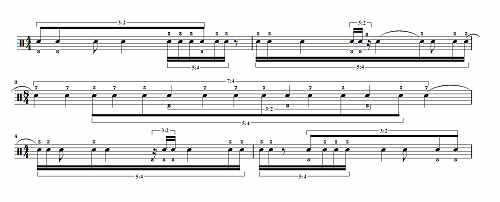
Here's a 3-part canon, not mine. It's playable. Can you play it? It's just a little canon. Play it now.